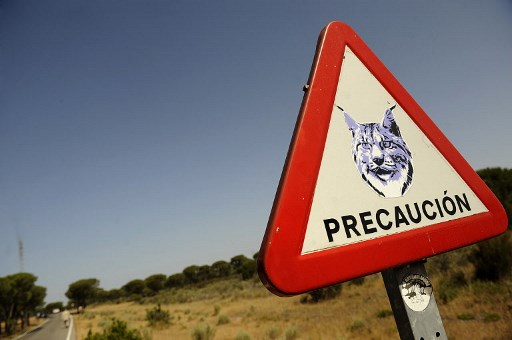How Spain brought the Iberian Lynx back from the brink of extinction

In 2002, the Iberian lynx was identified as the world’s most endangered cat, with just 94 left in the wild and looked all set to become the first species of cat to die out since the sabre-toothed tiger 10,000 years ago. Now, seventeen years later, the latest census shows that there at a healthy population of 686 individual Iberian lynx roaming the wilds of the southern Iberian Peninsula.
Why were they endangered?
Lynx pardinus was once found throughout Spain, Portugal and parts of southern France, with a population at the turn of the 20th Century estimated at some 100,000.
But, much prized for their luxuriant coat and as a trophy, years of over-hunting devastated the population, bringing the estimated number living in the wild to below 10,000 by the end of the 1980s.
Lynx numbers were further devastated as construction projects and new highways eroded their territory and made them roadkill.
READ ALSO: Spanish brown bear wanders across border into Portugal, the first in 175 years
But the danger was compounded by a loss of prey. When a myxomatosis epidemic swept across Spain, followed by the rabbit haemorrhage disease virus (RHDV) in the 1990s, it all but wiped out the rabbit population, which forms the staple diet of the lynx and their numbers shrunk further.
By 2002, the number of known individual lynx left in the wild was down to just 94, living in two isolated pockets of Andalusia - one in Doñana (Huelva) and another in Andújar (Jaén) - that occupied an area of 125 km squared.
Success of breeding programme

Lynx cubs bred at the captive breeding center of the Donana National Park: They will be chipped and released with an electronic tag. File Photo: AFP
In 2002, faced with the likelihood that the lynx would become extinct the Spanish government launched an emergency campaign to save Europe's largest cat and established a captive breeding programme which would culminate in them being reintroduced to the wild.
Thanks to joint funding between the EU and Spanish administrations to the tune of €100 million according to El Pais, four breeding centres have been established within Spain, and another in Portugal and have led to 185 young lynx being released into the wild over the past decade.
The lynx now number 686 at the last census and have a territory of over 3,064 km/sq spread across Andalusia, Castilla-La Mancha and Extremadura and across the border into southern Portugal. They have even been spotted in Madrid and, most extraordinarily, on the outskirts of Barcelona.
Such has been the success that in 2015, the International Union for the Conservation of Nature (IUCN) downgraded the danger of the Iberian Lynx from “Critically Endangered” to “Endangered” but indicated that if conservation continues in the same way it is likely to be listed as “Vulnerable” by the middle of the next decade.
Not out of the woods yet

A roadside warning drivers to be vigilent within known Lynx territory. Photo: AFP
Although the penalties for illegally hunting the elusive cats are huge and have put a stop to poaching, they still face other dangers.
Lynx are regularly reported to have been accidentally killed in traps laid by farmers to catch foxes, but by far the biggest danger is that of the roads.
During the past five years alone, close to 100 animals have been hit by cars and found dead at the side of the roads, a fact which conservationists hope to limit through the building of Culverts and ecoducts that cross under or over highways. A network of such structures are currently planned for the use of Lynx.
Comments
See Also
Now, seventeen years later, the latest census shows that there at a healthy population of 686 individual Iberian lynx roaming the wilds of the southern Iberian Peninsula.
Why were they endangered?
Lynx pardinus was once found throughout Spain, Portugal and parts of southern France, with a population at the turn of the 20th Century estimated at some 100,000.
But, much prized for their luxuriant coat and as a trophy, years of over-hunting devastated the population, bringing the estimated number living in the wild to below 10,000 by the end of the 1980s.
Lynx numbers were further devastated as construction projects and new highways eroded their territory and made them roadkill.
READ ALSO: Spanish brown bear wanders across border into Portugal, the first in 175 years
But the danger was compounded by a loss of prey. When a myxomatosis epidemic swept across Spain, followed by the rabbit haemorrhage disease virus (RHDV) in the 1990s, it all but wiped out the rabbit population, which forms the staple diet of the lynx and their numbers shrunk further.
By 2002, the number of known individual lynx left in the wild was down to just 94, living in two isolated pockets of Andalusia - one in Doñana (Huelva) and another in Andújar (Jaén) - that occupied an area of 125 km squared.
Success of breeding programme

Lynx cubs bred at the captive breeding center of the Donana National Park: They will be chipped and released with an electronic tag. File Photo: AFP
In 2002, faced with the likelihood that the lynx would become extinct the Spanish government launched an emergency campaign to save Europe's largest cat and established a captive breeding programme which would culminate in them being reintroduced to the wild.
Thanks to joint funding between the EU and Spanish administrations to the tune of €100 million according to El Pais, four breeding centres have been established within Spain, and another in Portugal and have led to 185 young lynx being released into the wild over the past decade.
The lynx now number 686 at the last census and have a territory of over 3,064 km/sq spread across Andalusia, Castilla-La Mancha and Extremadura and across the border into southern Portugal. They have even been spotted in Madrid and, most extraordinarily, on the outskirts of Barcelona.
Such has been the success that in 2015, the International Union for the Conservation of Nature (IUCN) downgraded the danger of the Iberian Lynx from “Critically Endangered” to “Endangered” but indicated that if conservation continues in the same way it is likely to be listed as “Vulnerable” by the middle of the next decade.
Not out of the woods yet

A roadside warning drivers to be vigilent within known Lynx territory. Photo: AFP
Although the penalties for illegally hunting the elusive cats are huge and have put a stop to poaching, they still face other dangers.
Lynx are regularly reported to have been accidentally killed in traps laid by farmers to catch foxes, but by far the biggest danger is that of the roads.
During the past five years alone, close to 100 animals have been hit by cars and found dead at the side of the roads, a fact which conservationists hope to limit through the building of Culverts and ecoducts that cross under or over highways. A network of such structures are currently planned for the use of Lynx.
Join the conversation in our comments section below. Share your own views and experience and if you have a question or suggestion for our journalists then email us at [email protected].
Please keep comments civil, constructive and on topic – and make sure to read our terms of use before getting involved.
Please log in here to leave a comment.